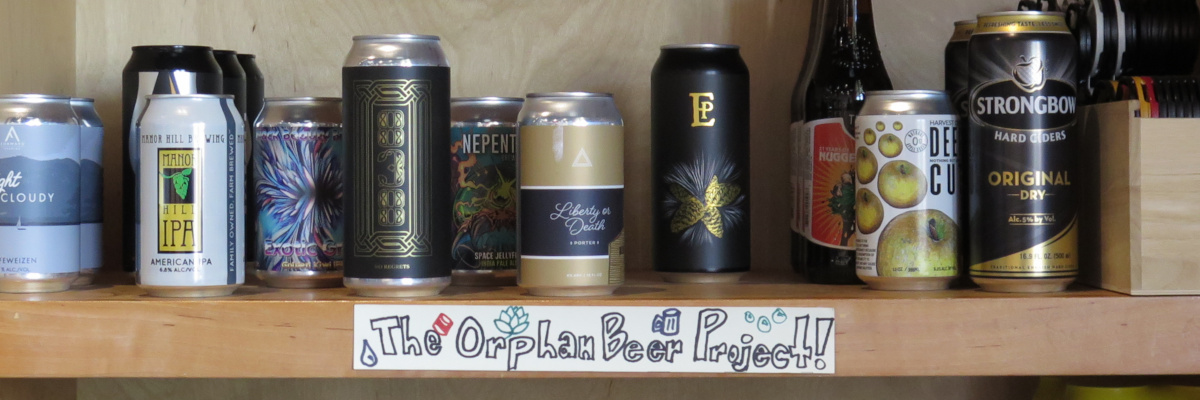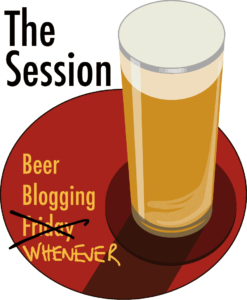
For the April edition of The Session, we’re asked where we find the greatest value in beer. I think overall I want choice, because I believe in context and the many moods of beer — in a given moment, I might be anywhere on spectrum from risk aversion to adventurousness, or from frugality to go on then, which isn’t quite the same thing. When breweries, retailers and venues push too hard on price-per-unit narrowly defined, that puts a thumb on the scale, distorting my deliberations and eroding other senses of the value of beer.
Pack mentality
The simplest expression of this follows something I mentioned in a previous Session contribution: one of the milder annoyances of moving here has been how almost everything in bottlestores, even breweries, is bundled into four- or six-packs. I’m happy to stamp this problem as solved; there’s a shop just a short ride up the MBT where they happily deal in one-offs — that’s their odds-and-ends shelf, above.

Because sometimes, I just want one. Maybe I’m taking a punt on something weird or unfamiliar I might get a pack of, next time. Or I’m keen to compare a few things, or just need a can of stout for some particularly delicious purpose. I’ll often add a strong and/or silly treat or two when I’m getting a half-dozen of something cheap and reliable. There’s a lot of different reasons for that buying behaviour and I really can’t see many good arguments not to accommodate it.1 I don’t expect a single to be one-quarter the price of a four pack; you can charge a little premium for the inconvenience. But there’s not that much extra admin or hassle, admit it. I’ve worked for breweries with significant takeaway trade, and we always had singles available. You’ll never have an exact number of packs, anyway: something will get dropped or have some packaging flaw discovered, or you’ll want to open one for staff training or to write tasting notes. Just embrace it, and offer people the option.
In Australia, the value-distorting problem often showed up at the other end: the effective discount of buying a full case was often shockingly steep — getting four six-packs for the price of three seemed to be about standard, and it wasn’t hard to find whole cases selling for only slightly more than half a case worth of smaller units.2 That seems wildly out of proportion to any actual efficiencies of scale involved. Now, beer is hardly a necessity,3 so this isn’t a Boots Theory situation of actual injustice. But it is annoying and a little alienating when you’d rather not spend beyond a certain amount or keep so much booze in the house, or simply prefer more variety.
Happy Hour necessarily implies other, unhappy ones
A similar problem also manifests on premise, when a sufficiently-dramatic deal offered on a particular product for a certain period can really sour your sense of value at all other times. There’s a fuzzy kind of limit to when I find this feeling kick in, and not every deal triggers it, but you can all too easily make someone like feel a bit of a sucker for not buying things in some pretty-arbitrary kind of way.4
And compromises must be made to make such things worthwhile and economical. Locked-in taps are a well known market-distorting problem, but volume discounts on keg purchases offered by breweries who reject such tactics can wind up having a similar effect at smaller scale. When I was the beer-buyer for a mid-sized bar I turned down such things, not wanting to queue up weeks’ worth of multiple repeats of something on one of our eight taps — I think our customers overall valued the variety more. This was especially true given our high proportion of regulars, who would be better-placed to notice one beer ‘stuck’ in the lineup. As-sharp-as-possible pricing is for venues that are more interchangeable and transactional. Those aren’t the places I prefer to go, and if you don’t want to seem like one, don’t act like one.
This brings us close to what I was talking about with my post for the last Session: a sufficiently complicated pricing structure just adds more friction, and forces more cognitive load (as Boak & Bailey described it, recently) on your customers, and staff.
In the extreme, there are of course some beers I don’t want at any price. But there’s also a very messy middle-ground where what looks like a discount feels like a bad deal in some wider context. If there’s a race to the bottom on price, craft or ‘indie’ or whatever-you-want-to-call-it will never win — and the risk of “cheapening your brand” feels like a pretty telling turn of phrase. Focus on other values.
- Apparently in some U.S. states, it’s outright illegal. But that’s a pragmatic reason not to, rather than a “good” reason in the fullest sense.
- I had a quick look on the Dan Murphy’s website and Coopers Pale was $23.99 for 6 or $56.95 for 24.
- Though I don’t love classing it as a “luxury” good, either. But that’s a tax policy discussion for another time.
- Plus, one of the absolute worst Kinds Of Guy who shows up to the bar is the one that rubs his hands together and conspiratorially asks “what deals can you offer me?” None, bro. None. And I worry that a barrage of posters with various specials only encourages the likes of him.
